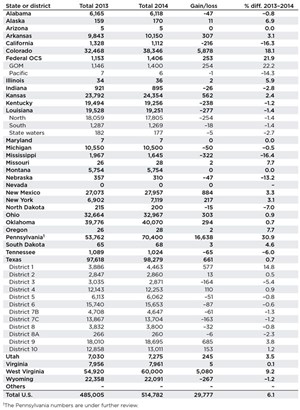U.S. gas well numbers rise despite low prices
The number of producing gas wells in the U.S. rose significantly over the course of the last year, despite prices that seldom crept above $4/MBtu. In 2013, there were 485,000 active producing gas wells in the U.S. In 2014, that number rose to 514,782.
Last year saw a number of U.S. states undergo significant increases in the number of gas wells. The mature gas province of Pennsylvania experienced the biggest percentage increase in the number of wells. During 2013, the state reported 53,762 active wells, but last year this figure increased above 70,000, based on revised previous-year figures. This represented a 30% increase, and contrasts with the state’s neighbor New York, which shares the prolific Marcellus shale formation. The Empire State did manage a 3% increase to 7,119 wells. West Virginia saw a large increase in terms of raw well numbers and percentage, increasing its count by 5,000 wells to around 60,000.
In terms of shear numbers, Texas continues without rivals. Last year, the Lone Star state saw a modest 0.7% overall increase, amounting to an additional 661 active producing gas wells. Within the state, District 9, in northern Texas, still leads the state in terms of active gas wells, with 18,695 wells reported last year, and also saw the largest increase, 685 wells, or a little more than 1%. District 1, in Central Texas, continued to grow, adding 577 wells for a total 4,463.
Oklahoma holds fourth place in terms of well numbers, managing a 294-well increase in 2014. Colorado saw an 18% increase, over 5,000 wells, for a total of 38,346, while Ohio saw a moderate rise of 303 wells to 32,967. Kansas also experienced a significant rise of some 562 wells, for a total of 24,354. Wyoming, which holds the number 8 position in gas wells, saw a small decrease of 1.2%, falling to 22,091.
There were small but significant declines of gas wells in several states. Louisiana, which has a large number of gas wells in its Haynesville shale region, declined by 277 to 19,251. Kentucky also experienced a decline of 238 wells to 19,256. Among other significant producing states, Mississippi lost 322, declining to 1,645 gas wells, while California lost 216 wells, falling to just 1,112.
Overall, one trend we will be watching will be a shift from oil as a preferred target to natural gas, as the price of crude has dropped below the level where unconventional oil plays, such as shale, can be economically produced. Gas has maintained a modest but more reliable price, and is regaining the attention of some operators. ![]()

- The last barrel (February 2024)
- What's new in production (February 2024)
- E&P outside the U.S. maintains a disciplined pace (February 2024)
- Prices and governmental policies combine to stymie Canadian upstream growth (February 2024)
- U.S. operators reduce activity as crude prices plunge (February 2024)
- U.S. producing gas wells increase despite low prices (February 2024)
- Applying ultra-deep LWD resistivity technology successfully in a SAGD operation (May 2019)
- Adoption of wireless intelligent completions advances (May 2019)
- Majors double down as takeaway crunch eases (April 2019)
- What’s new in well logging and formation evaluation (April 2019)
- Qualification of a 20,000-psi subsea BOP: A collaborative approach (February 2019)
- ConocoPhillips’ Greg Leveille sees rapid trajectory of technical advancement continuing (February 2019)



